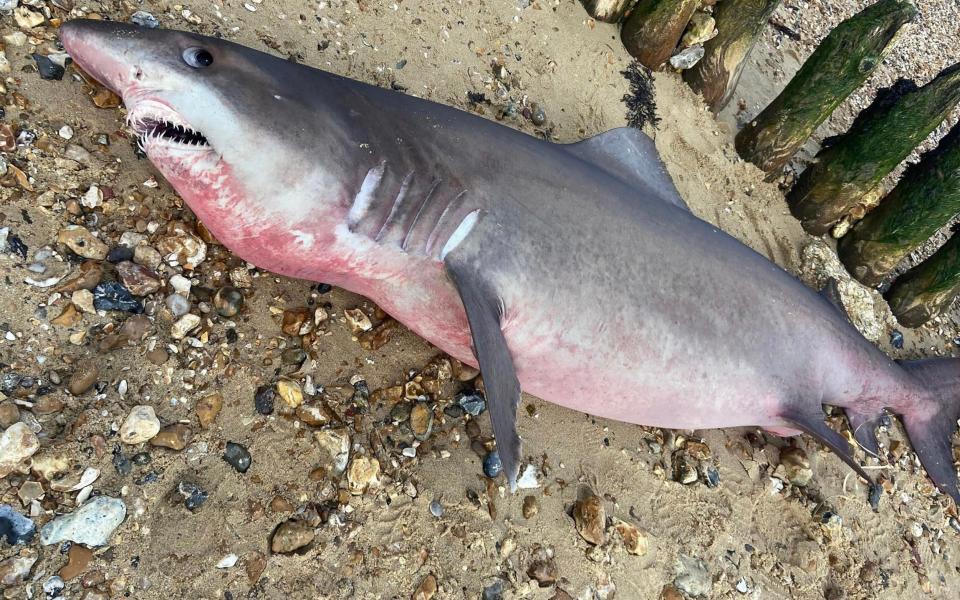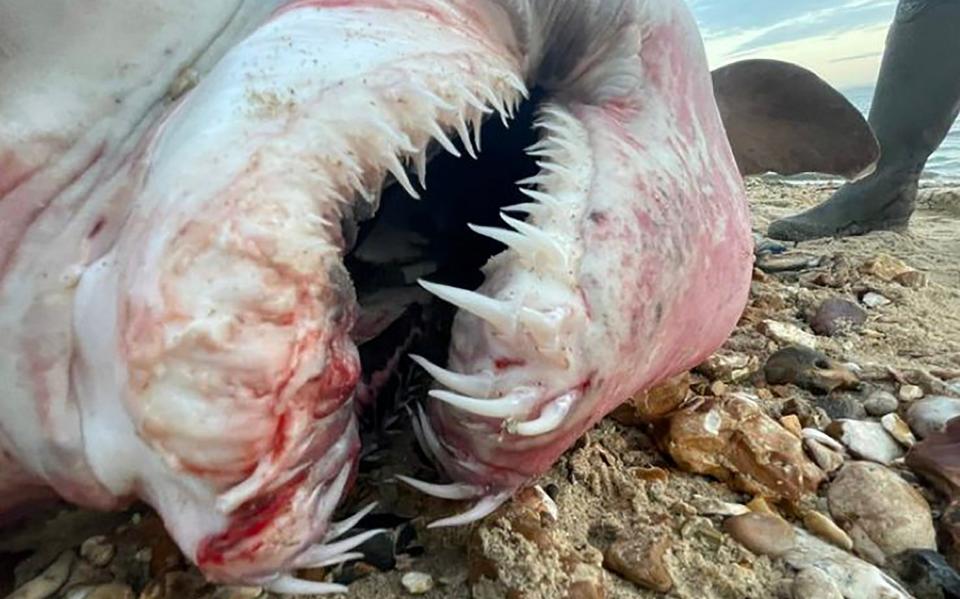Decapitated shark’s organs were removed by scavengers

The rare shark found washed up on a British beach has had some of its organs removed by scavengers, The Telegraph can reveal.
A large and extremely rare smalltooth sand tiger was found on Lepe beach in Hampshire on Saturday evening but by the time experts arrived at the scene on Sunday morning to retrieve the carcass vandals had already soiled the body, cutting off its head and most of its fins.
Now, it has emerged the shark was also disembowelled and some of its organs are missing.
It is believed to be the first time an individual of this species has been found in Britain and academics were hopeful to study the body to find out what led to its demise.
Sadly, scientists say that will now not be possible and that even if the head is returned it will now be too late to glean any meaningful information from the contaminated body parts.
No danger of rebuke
Historian Dan Snow, who tweeted about the shark on Saturday after it was found near his home, put out a call to arms urging the offal thieves to return the spoils of their overnight butchering.
“It is not illegal to take parts from dead fish washed ashore so there’s no judging but if you took the head please get in touch, let the scientists have a look and then it’s yours to keep,” Mr Snow pleaded on Twitter.
He told The Telegraph over the weekend that there was no danger of rebuke for the thieves, saying “it’s all fine but the scientists would love to see it”.
“It’s bound to be one of the many fishing enthusiasts in these parts,” he added.

However, despite the promise of clemency and an impromptu shark organ amnesty, the head has so far not been reunited with its body.
Experts from Zoological Society London (ZSL) have now collected the available remains and are driving it to the London headquarters for analysis.
“The head has been removed and the fins, or at least most of the fins, have been removed, and it’s also been eviscerated so a lot of the organs have been taken out,” Rob Deaville, head of the DEFRA-funded cetacean strandings investigation programme (CSIP) at the ZSL, told The Telegraph.
“Dan and his team did an amazing job trying to find what they could on the beach in the dark and pop those in the bag but from our perspective [the missing parts] damages what we can learn in terms of a post mortem investigation.
“It is like trying to do a jigsaw puzzle with half the pieces missing, you never get a full picture.”
Stealing fish parts not uncommon
Speaking on the phone with the remnants of the fish in the back of his car while in a service station on the M3, Mr Deaville said analysis will start on Tuesday night.
“I’m just getting some other work and emails out of the way with a fragrant shark in the back of the car while sitting in a car park and then I will head back into London and find some Magic Trees,” he said.
Mr Deaville called it sad and unfortunate that the corpse was ruined but said it is not an uncommon occurrence for people to steal parts of a stranded fish.
“It has happened before so to be honest with you I wasn’t actually that surprised. Things have a habit of going missing with some, but not all, strandings,” he said.
“We had a shark that was mutilated at the beach a few years ago in Wales; we’ve had sperm whales where people took teeth and entire jaws off the body, even a penis on one occasion; I remember disturbing some guys taking vertebrae out of a fin whale a few years ago because they were going to make it into a coffee table.
“Sometimes some people - by all means not all - do sometimes take things off animals they perhaps shouldn’t.
“Why do they do it? You’d have to ask them but I think some people might take bones because they think it will look nice on the mantelpiece.”
A special licence is needed for possession of such materials, he said, and the motivation for this theft remains unclear. The head is cartilaginous so if it was boiled down, it would not be an easy task to get a shark skull.
Difficult to study shark completely
The ZSL team are now hoping to preserve and study the shark and learn what they can. However, due to the extent of the missing parts the team will not be able to determine what led to the rare shark washing up dead on English shores.
Last year the CSIP team was dispatched to retrieve and study a 100-year-old juvenile Greenland shark and in that instance the body was found early on and was in pristine condition.
This led to a full postmortem being conducted and revealed the animal had a brain infection which led to it getting confused, getting stranded and dying on the sand. It is believed to be the first time ever a Geenland shark had been found with meningitis. However, no such detail will be possible with the Lepe shark.
The destruction of the intact corpse now makes the hunt for the head a futile endeavour as contamination has likely made it impossible to study.
“Even if you got the head back, or what was taken back, it would still have affected what we can collect because you need the body to be intact to sample organs in situ in a sterile manner and we are obviously past that point,” Mr Deaville said.
He is hopeful that some insights into the animal’s life, if not its death, can be gained from analysing its body.
“We will take what we can, I think there’s still some useful stuff we can collect,” he added.
“We’ve had quite a few sample requests from colleagues in the UK and elsewhere given the unusual species.
“We can collect some samples for toxicology, maybe learn what the animal has been exposed to in terms of manmade pollution while it’s alive.
“If the stomach and the spiral valve are still there we might be able to study dietary content to find out what it has been feeding on when it was alive and maybe to see if it has been feeding on microplastics accidentally. That’s more the angle we’re pursuing now, rather than an investigation about the cause of death.”

 Yahoo Movies
Yahoo Movies 